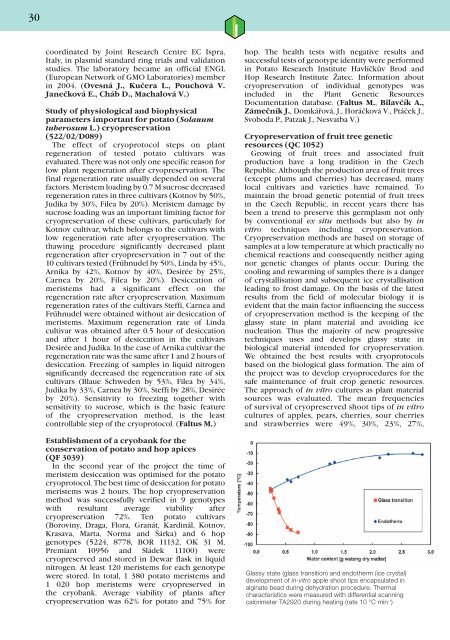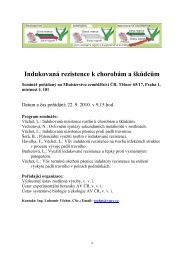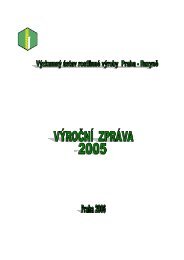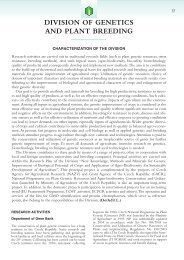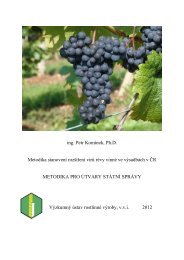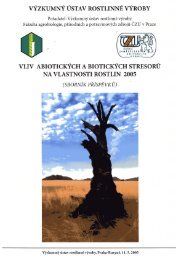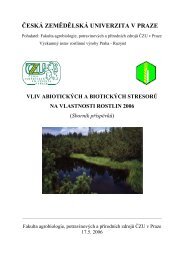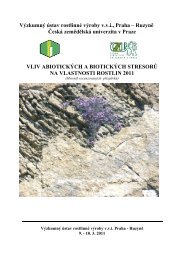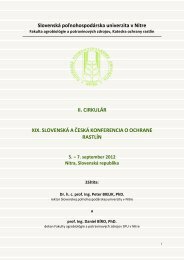Create successful ePaper yourself
Turn your PDF publications into a flip-book with our unique Google optimized e-Paper software.
30coordinated by Joint Research Centre EC Ispra,Italy, in plasmid standard ring trials and validationstudies. The laboratory became an official ENGL(European Network of GMO Laboratories) memberin 2004. (Ovesná J., Kučera L., Pouchová V.Janečková E., Cháb D., Machalová V.)Study of physiological and biophysicalparameters important for potato (Solanumtuberosum L.) cryopreservation(522/02/D089)The effect of cryoprotocol steps on plantregeneration of tested potato cultivars wasevaluated. There was not only one specific reason forlow plant regeneration after cryopreservation. Thefinal regeneration rate usually depended on severalfactors. Meristem loading by 0.7 M sucrose decreasedregeneration rates in three cultivars (Kotnov by 50%,Judika by 30%, Filea by 20%). Meristem damage bysucrose loading was an important limiting factor forcryopreservation of these cultivars, particularly forKotnov cultivar, which belongs to the cultivars withlow regeneration rate after cryopreservation. Thethawing procedure significantly decreased plantregeneration after cryopreservation in 7 out of the10 cultivars tested (Frűhnudel by 50%, Linda by 45%,Arnika by 42%, Kotnov by 40%, Desirée by 25%,Carnea by 20%, Filea by 20%). Desiccation ofmeristems had a significant effect on theregeneration rate after cryopreservation. Maximumregeneration rates of the cultivars Steffi, Carnea andFrűhnudel were obtained without air desiccation ofmeristems. Maximum regeneration rate of Lindacultivar was obtained after 0.5 hour of desiccationand after 1 hour of desiccation in the cultivarsDesirée and Judika. In the case of Arnika cultivar theregeneration rate was the same after 1 and 2 hours ofdesiccation. Freezing of samples in liquid nitrogensignificantly decreased the regeneration rate of sixcultivars (Blaue Schweden by 53%, Filea by 34%,Judika by 33%, Carnea by 30%, Steffi by 28%, Desiréeby 20%). Sensitivity to freezing together withsensitivity to sucrose, which is the basic featureof the cryopreservation method, is the leastcontrollable step of the cryoprotocol. (Faltus M.)Establishment of a cryobank for theconservation of potato and hop apices(QF 3039)In the second year of the project the time ofmeristem desiccation was optimised for the potatocryoprotocol. The best time of desiccation for potatomeristems was 2 hours. The hop cryopreservationmethod was successfully verified in 9 genotypeswith resultant average viability aftercryopreservation 72%. Ten potato cultivars(Boroviny, Draga, Flora, Granát, Kardinál, Kotnov,Krasava, Marta, Norma and Šárka) and 6 hopgenotypes (5224, 8778, BOR 11132, OK 31 M,Premiant 10956 and Sládek 11100) werecryopreserved and stored in Dewar flask in liquidnitrogen. At least 120 meristems for each genotypewere stored. In total, 1 380 potato meristems and1 020 hop meristems were cryopreserved inthe cryobank. Average viability of plants aftercryopreservation was 62% for potato and 75% forhop. The health tests with negative results andsuccessful tests of genotype identity were performedin Potato Research Institute Havlíčkův Brod andHop Research Institute Žatec. Information aboutcryopreservation of individual genotypes wasincluded in the Plant Genetic ResourcesDocumentation database. (Faltus M., Bilavčík A.,Zámečník J., Domkářová, J., Horáčková V., Ptáček J.,Svoboda P., Patzak J., Nesvatba V.)Cryopreservation of fruit tree geneticresources (QC 1052)Growing of fruit trees and associated fruitproduction have a long tradition in the CzechRepublic. Although the production area of fruit trees(except plums and cherries) has decreased, manylocal cultivars and varieties have remained. Tomaintain the broad genetic potential of fruit treesin the Czech Republic, in recent years there hasbeen a trend to preserve this germplasm not onlyby conventional ex situ methods but also by invitro techniques including cryopreservation.Cryopreservation methods are based on storage ofsamples at a low temperature at which practically nochemical reactions and consequently neither agingnor genetic changes of plants occur. During thecooling and rewarming of samples there is a dangerof crystallisation and subsequent ice crystallisationleading to frost damage. On the basis of the latestresults from the field of molecular biology it isevident that the main factor influencing the successof cryopreservation method is the keeping of theglassy state in plant material and avoiding icenucleation. Thus the majority of new progressivetechniques uses and develops glassy state inbiological material intended for cryopreservation.We obtained the best results with cryoprotocolsbased on the biological glass formation. The aim ofthe project was to develop cryoprocedures for thesafe maintenance of fruit crop genetic resources.The approach of in vitro cultures as plant materialsources was evaluated. The mean frequenciesof survival of cryopreserved shoot tips of in vitrocultures of apples, pears, cherries, sour cherriesand strawberries were 49%, 30%, 23%, 27%,Glassy state (glass transition) and endotherm (ice crystal)development of in-vitro apple shoot tips encapsulated inalginate bead during dehydration procedure. Thermalcharacteristics were measured with differential scanningcalorimeter TA2920 during heating (rate 10 °C min -1 )


